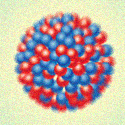Order out of chaos
The quest for order in nuclear spectra is an exciting problem in nuclear and particle physics. An extreme example of spectroscopic complexity is provided by the highly excited states of intermediate- to heavy-mass nuclides. For several decades, the dominant belief has been that this part of the nuclear spectrum is completely random in nature, leading to the development of several stochastic approaches to its study.
In a paper in Physical Review Letters, P. E. Koehler, J. A. Harvey, and K. H. Guber (Oak Ridge National Laboratory, US) in collaboration with F. Bečvář and M. Krtička (Charles University, Czech Republic), show that new data from the Oak Ridge Electron Linear Accelerator (ORELA) strongly disagree with this dominant lore. The data, which resulted from precision measurements of widths of neutron resonances, suggest collective, as opposed to chaotic, behavior of the constituent nucleons. This result challenges several nuclear models currently employed throughout nuclear physics, and even parts of astrophysics, while providing valuable clues into the mechanisms that produce the baffling complexity of nuclear energy levels. – Abhishek Agarwal





